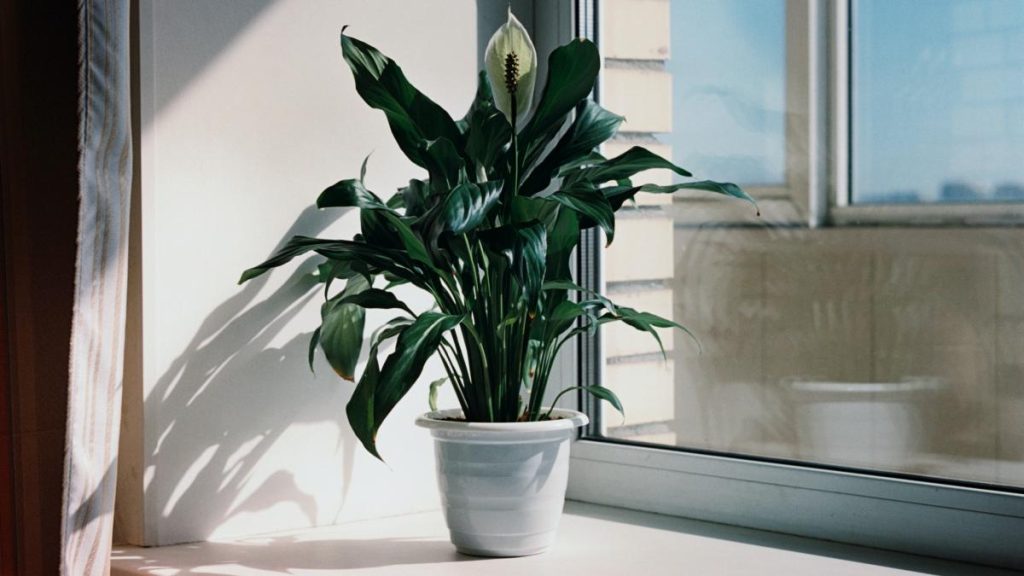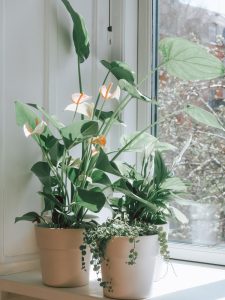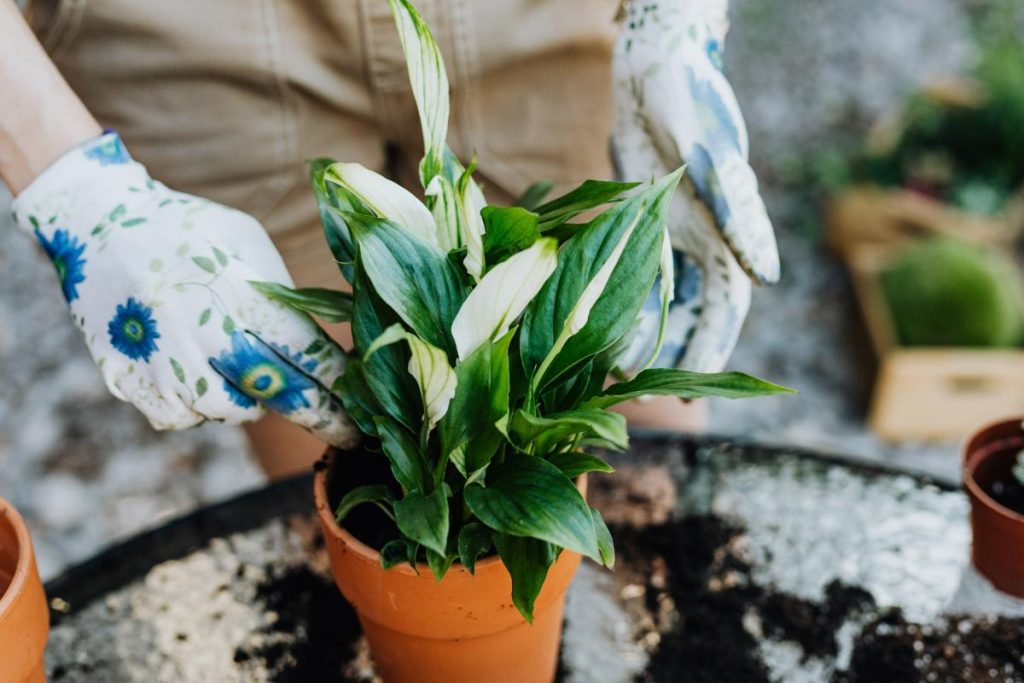Peace lilies are not only known for their elegant beauty, but also for the ease with which they can be cared for indoors. However, to truly help your peace lily flourish and fill your home with its stunning white flowers and vibrant green foliage, understanding its specific needs is crucial. In this guide on how to care for a peace lily indoors, we will delve into the essentials of peace lily care, ensuring that you can provide the perfect environment for your plant to thrive. Check these plants out at Prickle.
Key Takeaways
- Ensure optimal growth and blooming of peace lilies with ideal lighting conditions, proper watering techniques, right soil/potting mix & healthy environment.
- Fertilize according to manufacturer instructions for balanced nutrition & encourage blooms through deadheading spent flowers.
- Troubleshoot common issues such as yellowing or curling leaves and brown leaf tips by assessing care practices.
Indoor Peace Lily Care Essentials
Taking care of a peace lily indoors starts with understanding its basic needs. These tropical plants require moderate moisture levels, filtered sunlight, and consistent temperatures to truly thrive. Mastering peace lily care basics leads to a flourishing indoor oasis for your plant.
It’s time to delve into the crucial aspects of lighting, watering, and soil conditions for your peace lily, one of the many popular flowering plants.
Ideal Lighting Conditions
Peace lilies need bright, indirect light to grow and produce their striking white flowers. East-facing windows are ideal for providing the perfect amount of light without exposing the plant to harsh direct sunlight. Too much direct sun can cause the leaves to become pale and curl, which is detrimental to the plant’s health.
Most peace lilies can endure low light conditions but won’t prosper in utter darkness. If you notice your peace lily leaves suffering from pale color or a lack of blooms, consider moving your peace lily plant to a brighter location with ample indirect light. Remember, dappled sunlight is the key to helping peace lilies grow and maintaining a happy peace lily. In fact, proper care of peace lily plants can ensure their long-lasting beauty and health.
Proper Watering Techniques
Watering your peace lily correctly is vital for its overall health. These plants prefer consistently moist, but not soggy, soil. A good rule of thumb is to check the top inch of the soil before watering. If it’s dry, it’s time to water, but if it’s still damp, hold off for a day or two.
When it comes to water quality, water peace lilies are sensitive to chlorine found in tap water. To avoid chlorine damage, use filtered or distilled water to keep your plant hydrated.
Using well-draining potting soil helps avoid standing water and root rot, contributing to the health and vibrancy of your peace lily by maintaining the plant’s roots in dry soil conditions.
Soil and Potting Mix
Choosing the correct soil and potting mix plays a crucial role in the indoor growth and vitality of peace lilies. These plants prefer well-draining, nutrient-rich soil with organic matter that replicates their native tropical environment. This type of soil not only provides the necessary nutrients but also supports the plant’s roots, allowing them to breathe and absorb water efficiently.
When planting your peace lily, choose a high-quality potting mix that retains moisture without becoming waterlogged. This will ensure that your plant receives the proper balance of nutrients and moisture, promoting healthy growth and beautiful blooms.
Maintaining a Healthy Environment
Creating the perfect environment for your peace lily goes beyond just providing the right soil, water, and light. To truly help your plant thrive, you must also monitor and maintain the temperature, humidity levels, and air circulation within its surroundings.
We will now examine ways to care for peace lilies, including growing peace lilies, and foster a suitable environment for your peace lily.
Temperature Requirements
Peace lilies require a consistent temperature range between 65 to 80 degrees Fahrenheit to grow and bloom. These plants are not cold-hardy, so it’s important to keep them away from cold drafts or sudden temperature fluctuations that can cause stress and harm the plant.
To maintain the ideal temperature for your peace lily, keep it away from drafty areas, such as open windows or doors, and avoid placing it near heat sources like radiators or heating vents. Maintaining stable temperatures fosters lush green foliage and stunning white flowers in your peace lily.
Humidity Levels
As tropical plants, peace lilies thrive in moist environments with high humidity levels. To maintain the necessary humidity for your plant, you can mist its leaves with softened or distilled water weekly during the growing season. Alternatively, consider using a humidifier to raise the humidity levels in the room where your peace lily is located.
Another option is to place your peace lily on a tray filled with water and pebbles, ensuring that the bottom of the pot is not touching the water. The evaporation of the water will create a humid microclimate around your plant, providing the moisture it needs to thrive.
Air Circulation
Maintaining good air circulation is key to fostering a healthy environment for your peace lily. Proper air flow helps prevent mold and mildew growth, while also ensuring that the plant receives the necessary carbon dioxide for photosynthesis.
However, it’s important to avoid placing your peace lily near drafty areas, as cold drafts can cause stress and harm the plant. To provide adequate air circulation, place your peace lily in a well-ventilated area or near an open window, allowing fresh air to circulate around the plant.
If needed, you can use a fan to gently circulate the air during the summer growing season, but be sure not to expose the plant to strong winds or drafts.
Fertilizing and Encouraging Blooms
Fertilizing your peace lily is essential for promoting healthy growth and blooms. By providing the right type and amount of fertilizer, you can encourage your plant to produce its stunning white flowers.
Now, we’ll delve into the optimal fertilizers for peace lilies and share some tips to promote blooming.
Fertilizer Types and Frequency
Peace lilies benefit from:
- A balanced houseplant fertilizer applied every 6-8 weeks during the growing season
- Slow-release pellets at the beginning of the season
- A high-quality, water-soluble fertilizer designed for indoor plants
- Organic fertilizers, such as compost tea, fish emulsion, or seaweed extract, to provide essential nutrients
Over-fertilization should be avoided, as it can cause brown leaf tips and other problems. Always follow the manufacturer’s instructions for the correct amount and frequency to ensure your peace lily receives the nutrients it needs without causing harm.
Tips for Promoting Blooms
Maintaining consistently ideal conditions is key to encouraging blooms on your peace lily. This includes providing:
- Adequate light
- Water
- Humidity
- Proper fertilization
If your peace lily isn’t blooming, make sure it’s receiving enough indirect light, as too little light can inhibit flower production.
Another tip for promoting blooms is to deadhead spent flowers. Gently pinch off the spent flowers at the base of the stem, which encourages the plant to produce new blooms. By maintaining the right environment and care practices, you can help your peace lily produce an abundance of stunning white flowers.
Re-potting and Propagation
Re-potting and propagation are essential aspects of caring for your peace lily, ensuring its continued growth and vitality. Next, we’ll cover the optimal timing and methods for re-potting your peace lily along with effective propagation techniques.
When re-potting your peace lily, it’s important to choose a pot that is a size larger than the current pot but not too large.
When and How to Re-pot
Re-potting your peace lily is necessary when the pot becomes overcrowded or when roots become visible at the surface of the soil or through the drainage holes. It’s generally recommended to re-pot your peace lily every two to three years. When choosing a new pot, opt for a slightly larger terracotta or clay pot with good drainage.
To re-pot your peace lily, follow these steps:
- Gently remove the plant from its current pot.
- Place the plant in the new container, ensuring the root ball is centred.
- Fill the pot with a well-draining potting mix, leaving enough space for watering.
- Water your newly re-potted peace lily thoroughly to help it settle into its new home.
Propagation Methods
Peace lilies can be propagated through division, which involves separating the root clumps during re-potting. This method allows you to create new plants while maintaining the health of the original peace lily. To propagate your peace lily, gently remove it from its pot and carefully separate the root clumps, ensuring each new plant has a healthy root system.
Once the root clumps have been divided, plant each new peace lily in a suitable pot with well-draining potting mix.
- Water the newly potted plants thoroughly
- Place them in a location with bright, indirect light.
- With proper care, your new peace lilies will flourish and produce their own beautiful white flowers.
Troubleshooting Common Issues
Despite our best efforts, sometimes our peace lilies can experience issues that may affect their health and appearance. We will now tackle common issues like yellowing or curling leaves and brown leaf tips, and discuss how to address them to ensure your peace lily stays healthy and vibrant.
Yellowing or Curling Leaves
Yellowing or curling leaves on your peace lily can be a sign of too much light or sun exposure. If you notice this issue, try adjusting the lighting conditions for your plant. Move it to a shadier location or protect it from direct sunlight with a sheer curtain or shade.
Regular monitoring and necessary adjustments to your peace lily’s environment can avert yellowing or curling leaves. By providing the right balance of light and other care essentials, you can ensure that your peace lily remains healthy and vibrant.
Brown Leaf Tips
Brown leaf tips on your peace lily can be caused by a variety of factors, such as:
- Over or under-watering
- Poor soil drainage
- Low humidity
- Salt build-up in the soil
To resolve this issue, evaluate your care practices and make any necessary adjustments.
To guarantee proper watering of your peace lily, follow these steps:
- Check the top inch of the soil for moisture.
- Use filtered or distilled water to avoid chlorine and other chemicals that can harm the plant.
- If humidity levels are low, consider misting your plant or using a humidifier.
By addressing the underlying causes of brown leaf tips and providing proper care, you can help your peace lily regain its health and vitality.
Summary
Caring for a peace lily indoors requires understanding its specific needs and maintaining a healthy environment. By providing the right balance of light, water, soil, temperature, humidity, and air circulation, you can help your peace lily thrive and produce stunning white flowers. With a bit of attention and care, your peace lily will reward you with its elegant beauty and tropical charm, enhancing your indoor space for years to come.
Frequently Asked Questions
How often do you water a peace lily?
To keep your peace lily happy and healthy, you should water it weekly. In warm, dry climates, you may need to water more often, while in cooler or humid climates, you may need to water a bit less often. If the leaves start to sag, give your plant some water right away.
Should I cut the brown tips off my peace lily?
It is often the case that peace lilies can experience browning around the tips or edges of its foliage due to too much sunlight. To tidy up its appearance, you can trim these areas off – cutting ever so slightly into the green sections of the leaf.
Where is the best place to put a peace lily?
For optimal growth, peace lilies should be kept in bright, indirect light away from draughts, preferably in a humid bathroom.
Should I cut the dead flowers off my peace lily?
It is recommended that you use bypass pruners to deadhead the wilting or discolored “flowers” of your peace lily to keep the plant looking neat. Cut back to the bottom of the stem for the plant to send up more branches.
What type of soil is best for peace lilies?
Peace lilies thrive best in nutrient-rich soil with organic matter and good drainage, which closely mimics their natural tropical environment.






